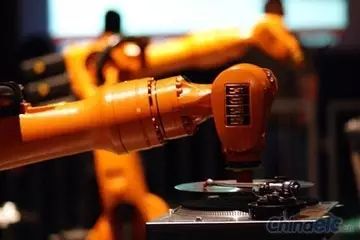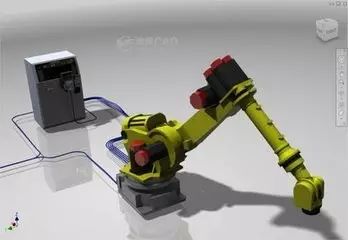1. Classification of Industrial Robots
1. According to the form of operating coordinates, they can be divided into:
(1) Cartesian Industrial Robots
The motion part consists of three mutually perpendicular linear movements (i.e., PPP), and its working space shape is rectangular. The movement distance in each axis can be read directly on each coordinate axis, which is highly intuitive, making programming calculations for position and posture easy. It has high positioning accuracy, uncoupled control, and a simple structure, but it occupies a large volume of space, has a small action range, poor flexibility, and is difficult to coordinate with other industrial robots.
(2) Cylindrical Industrial Robots
The motion form is realized by a motion system consisting of one rotation and two translations, with a cylindrical working space shape. Compared to Cartesian industrial robots, it occupies less volume under the same working space conditions, while having a larger movement range. Its positioning accuracy is second only to Cartesian robots, but it is also difficult to coordinate with other industrial robots.
(3) Spherical Industrial Robots
Also known as polar coordinate industrial robots, their arm movements consist of two rotations and one linear movement (i.e., RRP, one rotation, one pitch, and one extension movement), with a working space in the shape of a sphere. They can perform up and down pitching actions and can grasp coordinated workpieces on the ground or at lower positions. Their positioning accuracy is high, with positioning errors proportional to the arm length.
(4) Articulated Industrial Robots
Also known as revolute coordinate industrial robots, the arms of these industrial robots are similar to human upper limbs. Their first three joints are revolute pairs (i.e., RRR). These robots generally consist of a column and upper and lower arms, forming a shoulder joint between the column and upper arm, and an elbow joint between the upper and lower arms, allowing the upper arm to perform rotational and pitch movements and the lower arm to pitch. Their structure is the most compact, offering great flexibility with the smallest footprint, enabling coordination with other industrial robots, but their positioning accuracy is low, and they have balance issues and coupled control. These industrial robots are becoming increasingly widespread in application.
(5) Planar Joint Industrial Robots
They use one moving joint and two revolute joints (i.e., PRR), where the moving joint achieves up and down movement, and the two revolute joints control front-back and left-right movements. This type of industrial robot is also known as SCARA (Selective Compliance Assembly Robot Arm) assembly robots. They have compliance in the horizontal direction while having significant rigidity in the vertical direction. They have a simple structure and flexible movements, commonly used in assembly tasks, particularly suitable for the assembly of small parts, such as in the electronics industry.

2. According to the driving method, they can be divided into:
(1) Pneumatic Industrial Robots
This type of industrial robot is driven by compressed air. Its advantages are that the air source is convenient, movements are quick, the structure is simple and low-cost, and it is pollution-free. However, a disadvantage is that air is compressible, leading to poor stability in working speed. Additionally, since the air source pressure is generally only around 6 kPa, these industrial robots have relatively low lifting capacity, generally only a few dozen newtons, with a maximum of over one hundred newtons.
(2) Hydraulic Industrial Robots
Hydraulic pressure is much higher than pneumatic pressure, generally around 70 kPa, thus hydraulic-driven industrial robots have a large lifting capacity, reaching thousands of newtons. This type of industrial robot has a compact structure, smooth transmission, and quick movements, but has high sealing requirements and is not suitable for high or low-temperature environments.
(3) Electric Industrial Robots
This is currently the most widely used type of industrial robot, not only because there are many varieties of electric motors providing various options for industrial robot design but also because they can utilize various flexible control methods. Early models primarily used stepper motors, later developing DC servo drive units, and now AC servo drive units are rapidly advancing. These drive units either directly drive the operating machine or drive it through devices such as harmonic reducers after deceleration, resulting in a very compact and simple structure.

2. Industrial Robot Control Systems
1. The control technology of industrial robots
is developed based on traditional mechanical system control technology; thus, there is no fundamental difference between the two, but industrial robot control systems also have many special aspects.
Its characteristics are as follows:
(1) Industrial robots have several joints, with typical industrial robots having five or six joints, each joint controlled by a servo system, and the movements of multiple joints require the cooperation of various servo systems.
(2) The working task of industrial robots requires the end effector to perform spatial point movements or continuous trajectory movements. For the motion control of industrial robots, complex coordinate transformation calculations and inverse matrix functions are required.
(3) The mathematical model of industrial robots is a complex model that is multivariable, nonlinear, and has variable parameters, with coupling existing between the variables. Therefore, complex control technologies such as feedforward, compensation, decoupling, and adaptive control are often used in industrial robot control.
(4) Advanced industrial robots require the measurement and analysis of environmental conditions and control instructions, using computers to establish a large information database and employing artificial intelligence methods for control, decision-making, management, and operation, automatically selecting the best control laws according to given requirements.
2. Basic requirements for industrial robot control systems:
(1) To achieve control functions for the position, speed, and acceleration of industrial robots. For industrial robots performing continuous trajectory movements, trajectory planning and control functions must also be included.
(2) User-friendly human-machine interaction functions, allowing operators to use direct command codes to instruct industrial robots. The use of industrial robots should include memory, correction of operational knowledge, and the ability to jump between work programs.
(3) The ability to detect and sense external environments (including working conditions). To enable industrial robots to adapt to changes in external states, they should be capable of measuring, recognizing, judging, and understanding information related to vision, force, touch, etc. In automated production lines, industrial robots need to exchange information with other devices to coordinate work.
3. Classification of industrial robot control systems:
Industrial robot control systems can be classified from different perspectives. For example, based on the method of controlling motion, they can be divided into joint control, Cartesian space motion control, and adaptive control; based on trajectory control methods, they can be divided into point control and continuous trajectory control; based on speed control methods, they can be divided into speed control, acceleration control, and force control.
(1) Program Control Systems
Applying a certain pattern of control to each degree of freedom allows the robot to achieve the desired spatial trajectory.
(2) Adaptive Control Systems
When external conditions change, to ensure the required quality or to improve control quality based on experience accumulation, the process is based on observing the state of the operating machine and servo errors, adjusting the parameters of a nonlinear model until the error disappears. The structure and parameters of this system can change automatically over time and conditions.
(3) Artificial Intelligence Systems
These systems do not have pre-programmed motion procedures but require real-time determination of control actions based on surrounding state information obtained during motion. When external conditions change, to ensure the required quality or to improve control quality based on experience accumulation, the process is based on observing the state of the operating machine and servo errors, adjusting the parameters of a nonlinear model until the error disappears. The structure and parameters of this system can change automatically over time and conditions. Therefore, this system is a type of adaptive control system.
Source: Mechanical Frontier
Disclaimer: This article is a network reprint, and the copyright belongs to the original author. However, due to numerous reprints, it is impossible to confirm the true original author, so only the source of reprint is marked. If there are copyright issues with the videos, images, and texts used in this article, please inform us immediately, and we will confirm copyright based on the materials you provide and pay remuneration according to national standards or delete the content immediately! The content of this article reflects the original author’s views and does not represent this public account’s endorsement of their views or responsibility for their authenticity.
Click to read the original text, participate in the industrial robot survey, and get a 5 yuan no-threshold book discount coupon in just 3 minutes